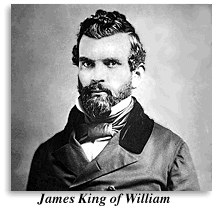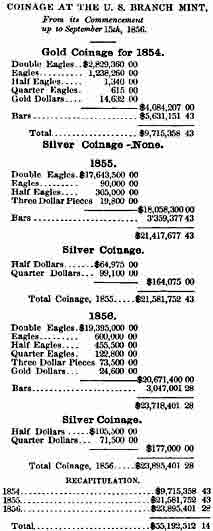Remarkable Record Is Made by Banks Here
FIRST OPENED IN 1849
Confusion Reigned During Golden Epoch
Through most of the 100 years of San Francisco’s commercial history, bankers have stood shoulder to shoulder with the commercial community in building the city’s greatness.
That the bankers have not figured in the entire century is due to the fact that the first bank did not open until fourteen years after the city’s commercial era began [in 1835].
 PAID CASH.
PAID CASH.
The hide and tallow trade that flourished in the early years of the nineteenth century required no bankers. The Yankee skippers paid cash for their merchandise and kept their merchandise and kept their money in the ship’s strong box.
The flood of gold-mad prospectors in late ’48 and early ’49, however, created a demand for banking. Henry M. Naglee opened the first bank in the city on Portsmouth Square on January 9, 1849. James King of William was a banker in the ’50s who forsook the counting house for the dangerous life of an editor.
CHIEF REQUISITE.
Of course, there was no such thing as locally chartered banking in those early days—the first chartered bank in California did not come on the scene until 1863. The chief requisite to become a banker in the wild and woolly days of ’49 was ownership of a strong safe.
Merchants were about the only persons in the town who owned safes, so it was natural that merchants became the first bankers. No knowledge of banking was necessary. In the wake of Naglee, fifteen or twenty other private bankers opened up to serve their customers.
 COINED MONEY. COINED MONEY.
One of the chief functions of a bank in those days was coining money. The United States Government did not open a mint [in San Francisco] until 1854. The State Constitution, adopted in 1850, forbade the issuance of paper money by banks.
Money confusion was indescribable. The perplexed ’49er found himself constantly confronted with Spanish doubloons, shillings, francs, florins, pesetas, guilders and rupees. American eagles and double eagles and a small amount of lesser coins alone represented the Government in this melange.
There was so little small change available that bankers imported change from Peru and the Spanish West Indies. The 12 1/2 cent “bit” which survives in the vernacular on the Pacific Coast probably had its origin at this time in the 12 1/2 cent Spanish real which was imported in large quantities.
SOLD EXCHANGE.
Other functions of the banker were safeguarding the deposits of miner, merchant and gambler, shipping gold to the East or selling exchange on the eastern cities or the homelands of the Argonauts.
The bankers congregated in the center of the booming town, around Portsmouth square and Montgomery street, and the financial center of the city still remains in that vicinity.
The first panic hit the city in 1855, when one of the express companies, which had engaged in banking, suspended. Angry miners stormed the closed banks. A tale is told that one of the banks informed its customers most of their money was put into building the bank’s structure. The depositors were cheerfully told they might help themselves to the bricks.
WEATHERED STORM.
The banking fraternity weathered this storm fairly well and continued their functions of ministering to the financial needs of the swift growing city. The mushroom growth of the mines turned to San Francisco for its financial support. The railroads came, helped by the banks. Shipping lines sent ships over the seven seas, with bank aid. The great silver boom came in the ’70s and the banks played their part.
Another era of banking trouble arose in 1875, precipitated by a forged paymaster’s warrant scandal.
WEAK ONES FAIL.
Weaker banks failed to survive, but the disturbance ushered in a long period of banking tranquillity. The San Francisco Clearing House was organized in 1876. A State Bank Commission was created in 1878. The panics of 1893 and 1907-8 came and went and the city’s banking structure waxed stronger. The ’20s saw an era of consolidation, merging and extension of branch banking. The constant aim was fewer and stronger banks.
RECENT RECORD.
The crowning achievement of San Francisco banking is said to be its remarkable record throughout the recent [1929] depression. With banks crashing by the thousands, year by year, elsewhere in the country, not a single San Francisco bank failed.
S.F. Mint Made Coins for Asia
The San Francisco branch mint, which has coined billions of dollars since its founding in 1854, has also coined money for scores of South American and Asiatic countries.
The San Francisco Examiner
October 15, 1935
Return
to the top of the page.
|